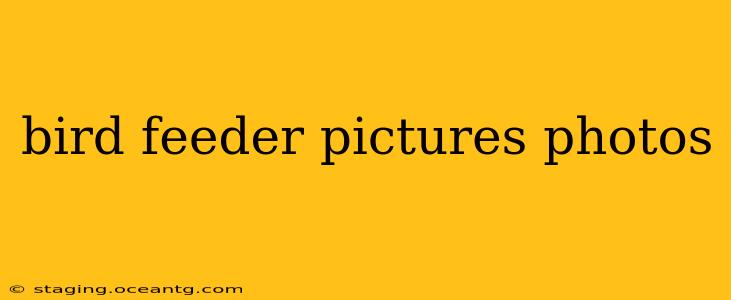Bird feeders are more than just functional tools; they're charming additions to any garden, providing a delightful spectacle of feathered friends and a unique photographic opportunity. From simple DIY creations to elaborate, store-bought designs, the variety is astounding, each offering its own visual appeal. This article explores the beauty of bird feeder photography, offering tips and inspiration for capturing stunning images, and answering some frequently asked questions.
What are the best types of bird feeders for taking pictures?
The best type of bird feeder for photography depends on your desired aesthetic and the birds you want to attract. Clear feeders allow for excellent views of the birds feeding, offering clean, uncluttered shots. Tube feeders, with their multiple feeding ports, can capture action shots of several birds simultaneously. Suet feeders, with their rich textures, provide visually interesting contrasts, and platform feeders offer a broad, easy-to-photograph feeding area. Ultimately, the "best" feeder is the one that attracts the birds you want to photograph and allows for the best possible composition.
What is the best time of day to take pictures of birds at a feeder?
The best time of day for bird feeder photography is generally during the "golden hours" – the hour after sunrise and the hour before sunset. The soft, diffused light of these times creates a warm, flattering glow on the birds' feathers, minimizing harsh shadows and enhancing detail. Midday sun, on the other hand, can create harsh contrasts and wash out colors. However, overcast days can also provide excellent, even lighting, ideal for detailed shots.
How do I get clear pictures of birds at my feeder?
Achieving clear bird feeder photos requires a combination of technique and equipment. A telephoto lens is crucial for capturing detail without disturbing the birds. A tripod is highly recommended to stabilize your camera and prevent blurry images. Consider using a fast shutter speed to freeze the birds' movement, especially if they're actively feeding. Patience is key; observe the birds' behavior to anticipate their movements and capture the perfect moment. Practice focusing techniques to ensure sharp images. Experiment with different aperture settings to control depth of field, blurring the background and emphasizing the bird.
What settings should I use on my camera for bird feeder photography?
Camera settings will depend on the lighting conditions and your personal style. However, a good starting point is a fast shutter speed (at least 1/500th of a second), a relatively high ISO (depending on your camera's capabilities and the light), and an aperture that balances depth of field with sufficient light gathering (f/5.6 to f/8 is a good range). Using your camera's continuous shooting mode allows you to capture multiple images in quick succession, increasing your chances of getting a sharp, well-composed shot. Experiment with different settings to find what works best for you and your camera.
What kind of background is best for bird feeder photos?
A blurred or uncluttered background enhances the subject (the bird). Avoid busy backgrounds that distract from the bird. Consider placing your feeder against a plain wall, a natural backdrop like trees or shrubs (slightly out of focus), or even a carefully chosen piece of fabric. A simple background allows the bird's colors and details to stand out, creating a more visually appealing image.
Where can I find good bird feeder photo inspiration?
Inspiration abounds! Search online platforms like Flickr, 500px, and Instagram using relevant hashtags such as #birdphotography, #birdfeeder, #wildlife photography, and #naturephotography. Explore nature and wildlife photography magazines and books for professional-level examples and techniques. Studying the work of accomplished bird photographers can significantly elevate your skills and creative vision.
By following these tips and employing a little patience, you can capture stunning bird feeder photos that showcase the beauty of nature and the joy of birdwatching. Remember, the most crucial ingredient is your passion for the subject. Happy shooting!
